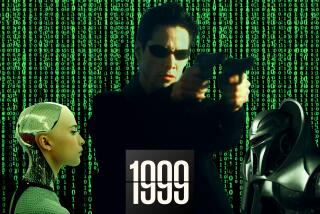Human-pixel synchronicity animates the TV landscape
- Share via
She’s a white-skinned apparition in a silk chemise, so blond she’s practically translucent. She walks through a heavenly landscape of waist-high grass and misty mountains . . . with her cellphone. The blissed-out, chorus-of-angels music rises. The woman (actress Tamara Hope) climbs a rocky outcropping and opens her new Palm Pre mobile device. The camera sweeps back to reveal 1,000 Chinese dancers in saffron pajamas arrayed in circles around her, a gyre of synchronized humanity. As she taps and finger-sweeps her way through the apps, the dancers animate the process: She touches a button and waves ripple through the throng; as she pushes one panel aside, the dancers fall away in rows.
Then comes the voice-over: “My life, like all our lives, is made up of so many other lives . . . all of them rearranging themselves, all the time. . . .”
For Palm, Toyota, Audi and others, this is the season of the human pixel.
The Pre spot -- by Boston’s Modernista agency -- is the latest ad to deliberately evoke the opening ceremonies of the 2008 Olympic Games in Beijing, which used thousands of people as pointillist elements to create dreamy, large-scale pictographs. In fact, one of the spot’s choreographers, Sun Yupeng, helped to produce the opening ceremonies.
This is the ultimate feel-good advertising. The very texture of the frame is made of shiny, happy people.
Busby Berkeley’s Depression-era spectaculars used overhead shots to create supple Spirographs formed by dancers’ bodies, and the flip-card displays at football games involve a technology that probably goes back to the Roman Colosseum.
But with the rise of social media like Twitter, performance artists have been able to rally volunteers on a grand scale -- such as last year’s Great Trafalgar Square Freeze (hundreds of volunteers stood motionless for about a minute).
Some of the most compelling, unskippable advertising of the last year has likewise used human beings as corpuscles of living, breathing animation.
Why now? There might be something deeper at work here than simple arty set pieces in post-Beijing euphoria. These ads are, after all, demonstrations of mass cooperation, human beings operating harmoniously, collectively and selflessly to make something beautiful.
Maybe we’ve forgotten that we could do that?
My favorite ad campaign of the year is this summer’s Toyota Prius series, landscapes made of performers costumed as blades of grass, tumbling white water, trees and blooming flower petals. The imagery is a perfect fit for the tagline: “Harmony between man, nature and machine.” Meanwhile, the orchestration of the performers -- duplicated into multitudes with computer-generated imagery -- is tremendously entertaining, like Cirque du Soleil with a cast of thousands.
Audi’s “Synchronized” spot for the new Q5 (by Los Angeles’ Psyop agency) likewise blends live-action photography and CGI to create scenes of hundreds of performers who form moving pictures of the Q5 hurtling along open roads using flip cards. In one sequence, the flip-card performers create a pretty convincing model of a six-cylinder engine firing. YouTube viewers will recognize the intricate flip-card technique from Korean sporting events.
A less ambitious but still entertaining human-pixel ad comes from the Dutch retailer HEMA, which recruited 144 middle-school kids to form a kind of dot-matrix display in a schoolyard. The kids clap three-ring binders together over their heads, and as they do the colors of the notebook pages change, creating a montage of images. This ad also resorts to some CGI trickery, but it’s still awfully cool.
One human-pixel campaign actually predates the Beijing Games, which only goes to show the notion was in the creative air. Vaseline’s award-winning 2007 campaign “Sea of Skin” (BBH of New York) featured hundreds of nude men and women elegantly pantomiming the script: Your waterproof barrier . . . the voice-over says, with the cast bobbing slowly in a hot spring. A defense against disease . . . knots of people forming what look like pores opening and closing. How you feel the world . . . hundreds of hands waving frantically like excited nerve endings.
There’s so much of this stuff out there that the human-pixel phenomenon has to be satisfying some urge. In the land of e pluribus unum, there’s not much unum to go around, alas. We are stratified, isolated and atomized about every way people can be alienated from one another, and live among waves of low-grade chaos.
Perhaps these ads simply hold out a kind of promise: It would be nice if we could synchronize ourselves, even for just one day.
--
More to Read
The biggest entertainment stories
Get our big stories about Hollywood, film, television, music, arts, culture and more right in your inbox as soon as they publish.
You may occasionally receive promotional content from the Los Angeles Times.










